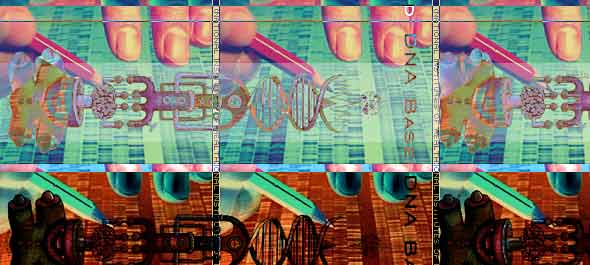BY LETTER
Biotech - the Early Years (old version)
 Image from Bernd Helfert |
The Difficult Early Years
As early as the start of the Information Age, huge strides were made in biotechnology, including the great breakthrough that was the Human Genome Project at the turn of the 21st century, gave man total control over the genetic code of life. Yet, as with any new technology, biotech faced a difficult birth. The reasons were many: over-exuberance and excessive hype, and often underestimations of the difficulties and costs involved (a common factor in newly emerging technology in the capitalist economies of the Late Industrial and Early to Mid Information Ages); public prejudice, criticisms, fears, and resistance from various quarters, especially in democratic nations; and competition from inorganic technologies in many fields and markets. Various well publicized accidents, mistakes, and terrorist incidents involving biotechnology in one way or another, all served to limit and retard many other biotech developments.Not the least of biotech's problems were some similar to those faced by the early internet of some 20 to 30 years earlier -- outrageous actions by some companies which practically forced governments to step in with new laws and regulations to moderate things, and the related spillover into other fields such as personal privacy and discrimination in employment, health insurance, and other matters.
Throughout the early to middle 21st century the agribusiness and biotech megacorporations like Monsanto and Celera Genomics continued to face huge opposition from a diverse and squabbling alliance of citzens consumer rights, environmental activist, religious, and neo-luddist, groups, all of which in different ways played on public hysteria.
The Rise of Biotech in the non-Western Nations
During the middle and later part of the Information Age, this moral dithering in the western world allowed China, India, and various small non-western states to become leaders in biotech (at least until the rise of the Free Zones and the Orbital States in the early Interplanetary Period). The biotech revolution largely bypassed pre-existing power structures, and relatively small, independent groups and corporations could quickly become significant.The blacker aspects of gengineering, the ones that were less accepted by common consensus, like optimizing body shape to produce everything from a human sex toy to the perfect soldier, cloning brainless copies of oneself as organ donors or playing around to explore the effects of genetic changes on human beings, were mostly attempted in countries with little or no regulation. The governments of extremely impoverished nations like Cuba, Mali or Vietnam could be bribed or persuaded into allowing a wide range of ethically dubious research into biotech/gengineering/cyborging, while claiming to make their nation the Capital of the Scientific world.
What often happened was that one of the big megacorps of the age, like Hitachi Biosciences Inc. or Zeiss Forschungsgesellschaft Kuenstliche Sinnesorgane mbH would purchase an area of 10-25 sqkm in one of these countries, fenced it off with heavily armed guards (preventing bioterrorists from stealing contaminated material, the corporate PR divisons claimed) and put in everything needed in modern civilization like food supplies, a clean water supply, living quarters and an airport. The research facilities and hospitals were built and operated by well-paid scientists hired everywhere on the globe, attracted either by money (especially the ones from developing nations) or, more often, by freedom of research without legal regulations (especially researchers from the industrial nations tired of having to go through year-long approval routines for each and every experiment). These scientific mercenaries, even though frowned upon by their colleagues in universities brought about a lot of the genemod and cyborgization techniques that became global standards later on.
Extremely dangerous experiments (ususally involving gengineered retrovirus strains used to reprogramm an adult genome) were performed on semisubmersible platforms in international waters. Several of these were destroyed using their built in thermite sterilisation charges after a potentially dangerous microbe had gotten out (this was the reason for even higher salaries on these platforms)
Institutions like the research enclaves and platforms played an important role in many biotech advancements, especially among some of the late info age start-ups like Modernbody, GeneTEK, and Biotopia.
Biotech comes into its own
In the second half of the 21st century c.e. biotech finally began to enjoy a great liberalization in laws and regulations, as well as a collapse in costs and relative difficulty and access. Advanced biotech finally became mainstream, and becomes available in everything from school childrens' lab kits to adult pet/companion generators and 'living' structures such as homes and recreational vessels.Human beings, at least those in wealthy countries or themselves possessing wealth, were able to choose the genetic makeup of their offspring, and even at the end of the century retro-engineer their own genetic makeup. And with genes either patented or public domain, the race was on to create and exploit the economic potential of artificial lifeforms.
As the 22nd century dawned (= mid 2nd century AT), and with the new spirit of optimism that accompanied the construction of orbital microworlds and the colonization of space, the influence of these groups waned and a flurry of biotech companies sprang up to exploit this new market, including Biotopia, GeneTEK, Modernbody, Chang Agribusiness, among others (The old Celera Genomics having long since gone the way of Microsoft for violating anti-trust laws, one of the last of the big megacorps to suffer that fate before the nation state found itself entirely in the pocket of global capitalism). The result was the first cladization of the human race (what was later to be termed the "root of the anthropogenic radiation") into splices (megacorp gengineered animal-human hybrids), tweaks (transhumanists and cosmists who have sought to enhance their own biological evolution) and (although not a part of biotech) digital-interfacing cyborgs (including the cyberians and the gibsons).
Development Notes
Text by Martin Andreas Cieslik, M. Alan Kazlev, and J.R. Mooneyham
Initially published on 27 March 2001.
Initially published on 27 March 2001.






